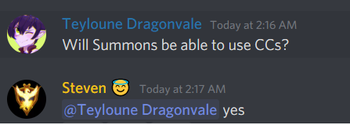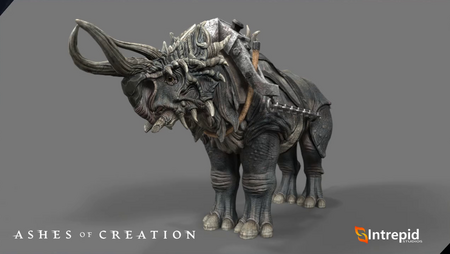Summons
The summoner uses abilities that channel through their summons (also referred to as class skill pets).[1][2]
- You gain your summons from your summoner class as an active skill and then skills can be further developed with points.[4] – Steven Sharif
- Abilities from the summon appear on the summoner's hotbar. The summoner is essentially playing through their summon.[1][2]
- Summoners will not be able to fuse with or be taken over by their normal summons.[1][2]
- In the case of siege summons the summoner does become the summon.[1][6]
- Summoners may also have the ability to transfer pain to their summons, meaning that a portion of damage or threat taken by the summoner can be transferred to their summon instead.[7]
- Summoner summons are not the same as combat pets.[8]
- Summoner's summons will add to the summoner's power when they are summoned, unlike combat pets, which take a portion of the player's power.[9]
- The Summoner archetype does not have that portion of power taken away when they summon their pet. That's part of their... power is their summon.[9] – Steven Sharif
- Summons will exist until another summon is cast, the summon is killed, or the summoner logs off.[10]
- Summons can be leveled through the application of skill points to their active skill.[4]
- Summons will be able to use crowd control (CC).[11]
- Summoners may be able to name their summons, but will not be able to change their creature type, which is part of the nameplate above the summon.[12]
- Summons follow the same PvP flagging rules as players and share the player's flag status.[13][14]
- Summons follow the same flagging rules as players, if your summon pks someone, you gain corruption[13] – Steven Sharif
Summoners summon different varieties of summons, depending on the class and augments they choose.[15][16]
- Animals.[16]
- Spirits.[16][17]
- Skeletons, zombies and other undead summons will be possible with death-based cleric augments.[10][17]
- Corpses (potentially).[16]
- Some summoners may summon multiple things.[16]
- Other summoners may only summon one powerful thing.[16]
- Certain summoners may only be able to summon effects and/or temporary energies.[16]
Augments from a secondary archetype can be applied to a summon.[18]
- For example: If your summon had a sweeping attack with a claw, or had the ability to bite an opponent, or rush an opponent; and you took teleportation, you could rush them similar to how I've given an example with the tank: Teleporting to a target instead. Or, its claws could combust on impact on a target dealing some burn damage that persists. Or... let's say your summon traditionally was some type of bear or bear cat, you could apply an elemental augment and now it could be a transparent flaming bioluminescent cat; and its damage would be fire based. So, that's how we want to influence the active skills with how augments apply; and that's how it would apply with Summoners.[18] – Steven Sharif
Summon appearance
Summoners can change the appearance of their summons.[16][19]
- Through in-game items.[16]
- Through cosmetics.[20][16]
- Potentially through a summon creation suite, based on the Animal husbandry system.[21][22]
- The great thing about the animal husbandry tech that we're creating and the idea of having customization options is that there might be some opportunity there to really create a more customized experience for the summoner and the types of visual representation that their creature has that's more to the players definition. But we will see about that. I think you guys will be getting some updates in the future about that.[21] – Steven Sharif
A summon's appearance is determined by in-game choices.[19]
- Class specific appearance.[19]
- For example: Summoner/Rogue (Shadowmancer) may have shadow summons.[19]
- Race specific appearance.[19][23]
Siege summons
Group summons are activated by a party leader with that ability in their class kit along with additive components from other classes that are part of the group.[25]
Up to eight players of the same primary archetype can band together to create monumental effects during a siege.[26]
- These are the types of systems that we want to put in place where groups of a single primary archetype can come together to summon these types of effects that play off of what the identity of that archetype is.[26] – Steven Sharif
Summoners can collaborate together during sieges to summon larger creatures, such as Golems.[1][27][2]
- We do have the concept of siege summons being a thing with multiple summoners being required in order to create that siege summon. In those situations your character becomes the summon. So you don't have an AI that takes over your previous character but instead the recipient of those additional spell effects becomes the actual summon itself.[1] – Steven Sharif
- The target of the group summon becomes the summon itself.[1][2]
- Previously it was stated that the party-leader becomes the summon.[27]
- A siege summon will have an incremental size based on the number of summoners participating in that summon activity, with a maximum of eight.[28]
- The number of summoners participating in the summon will determine its overall size.[28]
- All summoners must be in the same party and the party leader must be a summoner.[27]
Timeline
The Summoner archetype is expected to be present during Alpha-2. It could even be present at the beginning.[29]
- Previously it was stated that Summoner may not be present at the beginning of A2.[30][31][32]
- Summoner was originally scheduled for Alpha-1.[33]
Visuals
2020-08-01
See also
References
- ↑ 1.0 1.1 1.2 1.3 1.4 1.5 1.6 1.7 Livestream, March 31, 2023 (1:22:21).
- ↑ 2.0 2.1 2.2 2.3 2.4 2.5 Livestream, May 19, 2017 (10:06).
- ↑

- ↑ 4.0 4.1 Interview, August 8, 2018 (22:27).
- ↑

- ↑ Livestream, May 26, 2017 (43:20).
- ↑ Livestream, February 24, 2023 (1:27:22).
- ↑ Livestream, October 30, 2020 (1:21:14).
- ↑ 9.0 9.1 Interview, January 14, 2022 (42:18).
- ↑ 10.0 10.1 Livestream, July 25, 2020 (1:41:46).
- ↑

- ↑ Livestream, January 29, 2021 (1:21:01).
- ↑ 13.0 13.1

- ↑

- ↑ Interview, June 13, 2021 (13:11).
- ↑ 16.0 16.1 16.2 16.3 16.4 16.5 16.6 16.7 16.8 16.9 Livestream, 2018-04-8 (AM) (0:58).
- ↑ 17.0 17.1 Livestream, 2018-04-8 (PM) (11:27).
- ↑ 18.0 18.1 Livestream, 2018-04-8 (PM) (24:11).
- ↑ 19.0 19.1 19.2 19.3 19.4 Livestream, May 17, 2017 (1:07:55).
- ↑ Interview, July 9, 2023 (1:08:13).
- ↑ 21.0 21.1 Interview, July 9, 2023 (1:10:46).
- ↑ Livestream, January 30, 2020 (1:26:09).
- ↑

- ↑ Livestream, November 22, 2019 (41:02).
- ↑ Livestream, January 27, 2023 (1:33:42).
- ↑ 26.0 26.1 26.2 Podcast, May 11, 2018 (49:20).
- ↑ 27.0 27.1 27.2 27.3 27.4 27.5 27.6 Interview, August 17, 2018 (14:59).
- ↑ 28.0 28.1 Livestream, 2018-04-8 (AM) (28:01).
- ↑

- ↑ Interview, July 9, 2023 (1:11:29).
- ↑ Interview, July 9, 2023 (1:06:53).
- ↑ Interview, October 17, 2020 (53:50).





